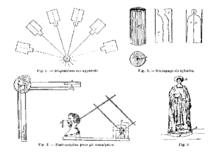Photo sculpture
Diagram from the U.S. patent application
Photosculpture of François Willème from the 1860s

Series of photographs taken in 1865 for photosculpture
Willème's rotunda laboratory at 42 Avenue de Wagram in Paris

Two photographs for a photosculpture, of the King Consort of Spain, Francis, Duke of Cádiz ( It can be seen Queen Isabel II in the background )

Magazine illustration explaining the process (1897)
A photo-sculpture is the reproduction of persons, animals, and things, in 3-dimensions by taking a series of photos in the round and using them as synchronized photo projections to create a sculpture.[1] The process was invented and patented by French artist (painter, sculptor and photographer) François Willème in 1860. He took a series of photographs from around a subject and used them to carve a likeness of the figure.[2] Contemporary photo sculptures are obtained through a process of 3D scanning and 3D printing. The results are small statues that represent the portrayed entity.
Examples of photographic sculptures include the work of experimental artist Oliver Herring.
References
- ↑ "Photosculpture". Oxford Companion to the Photograph. Answers.com © Oxford University Press. 2005. Retrieved June 23, 2012.
- ↑ http://artradarjournal.com/2015/02/27/what-is-photosculpture-art-radar-explains/
Additional sources
- Sobieszek, Robert A. 1980. "Sculpture as the Sum of Its Profiles: François Willème and Photosculpture in France, 1859-1868". The Art Bulletin. 62 (4): 617-630.
- Leticia Azcue Brea y Mario Fernández Albarés. "La Photoscultpture. Su desarrollo en la España de Isabel II (1860-1868) = Photosculpture. Its development in the Spain of Isabella II (1860-1868)". Academia: Boletín de la Real Academia de Bellas Artes de san Fernando, Nº 116. Primer y segundo semestres de 2014, pp. 109-154, Madrid 2015, (es separata, español / inglés).
This article is issued from Wikipedia - version of the 8/18/2016. The text is available under the Creative Commons Attribution/Share Alike but additional terms may apply for the media files.